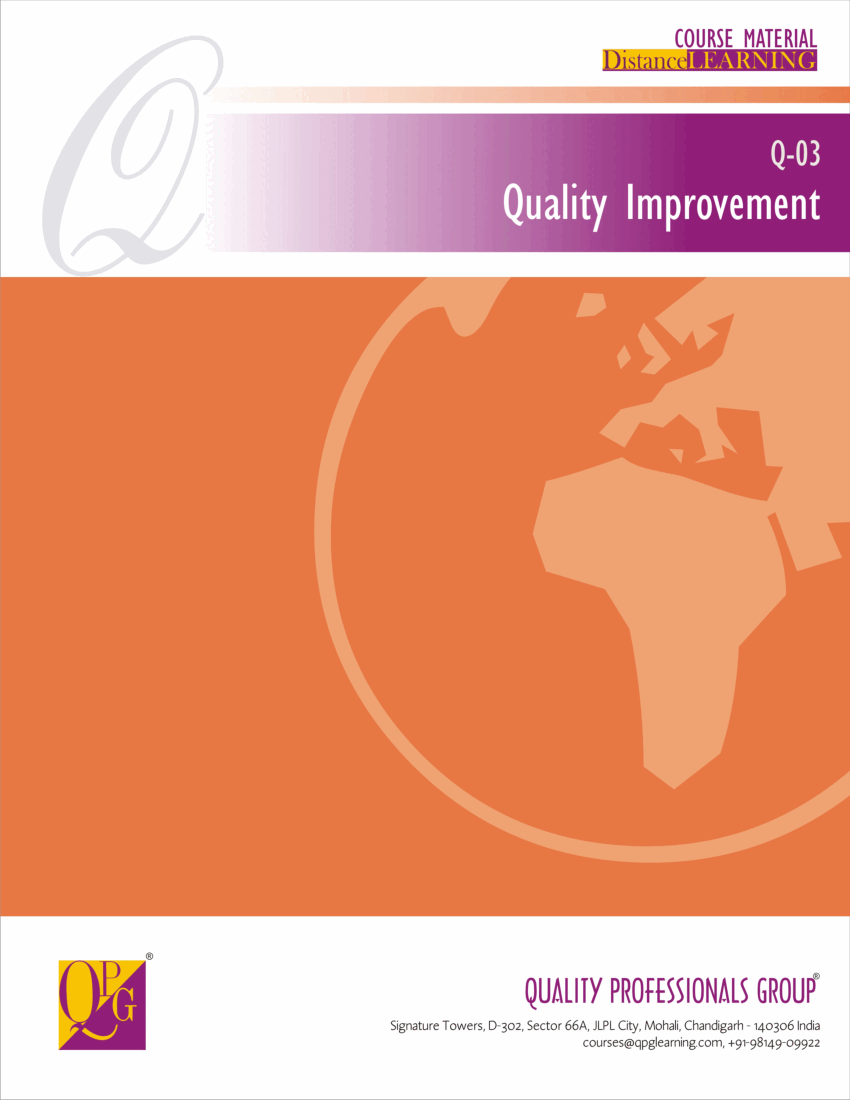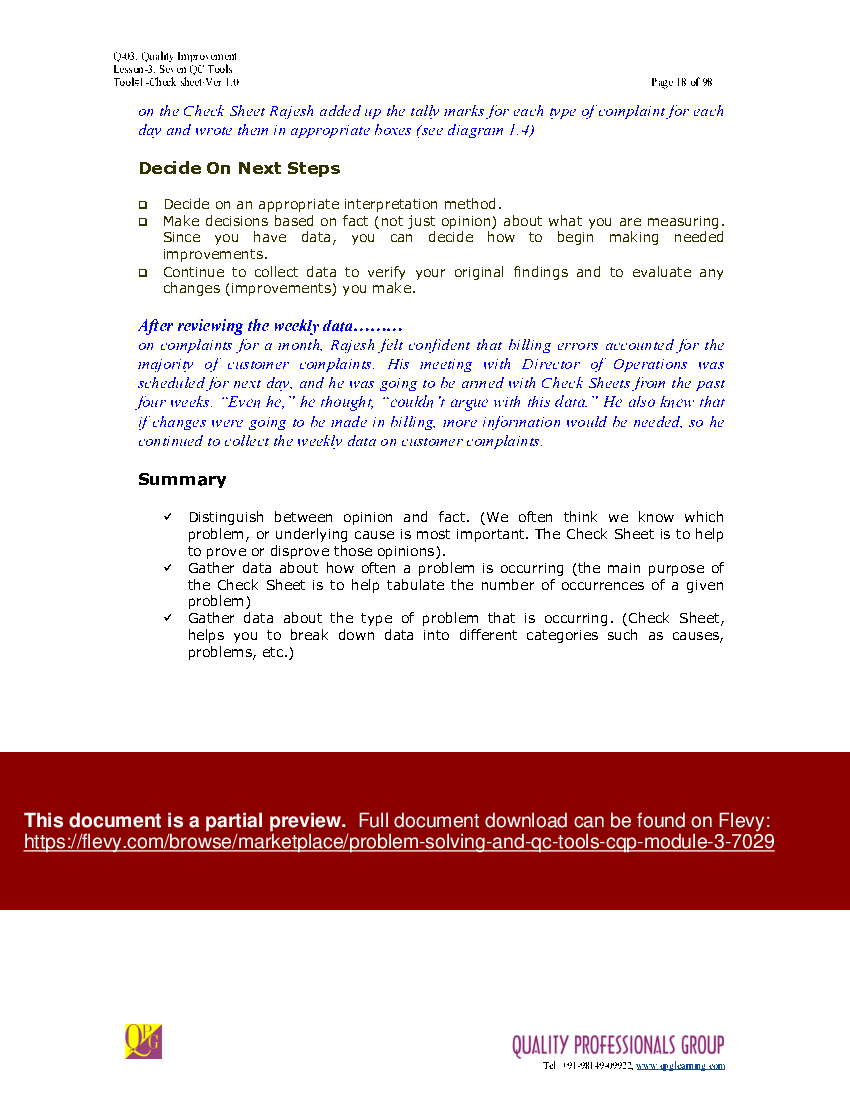Problem Solving & Quality Control (QC) Tools (CQP Module 3) (PDF)
PDF document 99 Pages
BENEFITS OF THIS PDF DOCUMENT
- Educates the user on systematic Problem Solving methodology based on the famous PDCA cycle
- Describes various Quality Tools (7-QC tools as well as other important tools) with specimen cases and calculations
- Describes the various types of performance measures and the methodology for improving processes in an organization.
PROBLEM SOLVING PDF DESCRIPTION
Certified Quality Professional (CQP) is an excellent program on 'Quality Management' brought out by Quality Professionals Group (QPG). The contents of this program are now available for download on as different Modules. These documents in pdf consist of different lessons of the various Modules of the program.
There are 5 different modules of the program and cover the most relevant topics on quality management for current use by the industry. The program is useful both for application in the manufacturing as well as in the service sector. The language & contents of the program are well researched and are given in a format that is easy to understand & comprehend. The modules are available as separate documents as well as a bundle document.
This document is the 3rd in the series of the program and covers the Module-3 titled,
'Quality Improvement'
The Module covers the following topics on the subject of 'Quality Improvement':
1. Problem Solving
2. An Overview of Quality Tools
3. Seven Quality Tools
4. Other Quality Tools
5. Performance Measurement
In this document you will learn about the following:
a) What is structured problem-solving methodology as per the PDCA cycle and what are the steps involved in it
b) What are the various QC tools that can be used at different stages of problem solving and an overview of the Tools Matrix
c) Detailed description of the famous seven QC tools, including the steps involved in each one of them. The usage of the tools is explained with specimen cases from workplace situations.
d) Detailed description 6 other popular tools that are used frequently by the industry for problem solving & quality improvements.
e) How to measure the performance of processes in an organization and make improvements, including discussions on difference between continuous & continual improvement, between efficiency & effectiveness, how to create & measure SMART performance indicators, elements of successful improvements and examples of performance measures for quality, productivity & service quality.
The details of the sub-topics covered in the document are:
Lesson 1: Problem Solving
1. Introduction
2. Structured problem solving – why?
3. The problem-solving method
3.1 PDCA Cycle
3.2 Structured Problem Solving
4. Success Factors in problem solving
5. Problem Solving and QC Story
6. Overview of Problem-Solving Process
Lesson 2: An Overview of Quality Tools
1. Introduction
2. Seven QC Tools
3. Seven New Management and Planning Tools
4. Other Useful Tools
5. Tools Matrix
Lesson 3: Seven QC Tools (Tool #1: Check Sheet)
Check Sheet
Step 1: Clarify Your Measurement Objectives
Step 2: Identify What You Are Measuring
Step 3: Determine the Time or Place Being Measured
Step 4: Collect the Data
Step 5: Total the Data
Decide on Next Steps
Summary
Lesson 3: Seven QC Tools (Tool #2: Histogram)
Histogram
Step 1: Gather and Tabulate the Data
Step 2: Calculate the range:
Step 3: Draw the Horizontal and Vertical Axes
Step 4: Tabulate the Data by Intervals
Step 5: Plot the Data
Step 6: Analyze the Histogram
Follow-Up: Decide on Next Steps
Summary
Lesson 3: Seven QC Tools (Tool #3: Cause & Effect Diagram)
Cause and Effect Diagram
Step 1: Prepare for the Cause and Effect Session
Step 2: Identify the Effect
Step 3: Identify the Major Cause Categories
Step 4: Brainstorm Potential Causes of the Problem
Step 5: Review Each Major Cause Category
Step 6: Reach an Agreement on Most Probable Cause(s)
Decide On next Steps
Summary
Lesson 3: Seven QC Tools (Tool #4: Pareto Chart)
Pareto Chart
STEP 1: Identify the categories of problem or causes to be compared
STEP 2: Select a standard unit of measurement and the time period to be studied
STEP 3: Collect and summarize data
STEP 4: Draw the horizontal and vertical axes
STEP 5: Plot bars on the Pareto Chart
Follow-up: Decide on the next Steps
Summary
Lesson 3: Seven QC Tools (Tool #5: Part 1-Run Chart)
Run Chart
STEP 1: Determine what to measure
STEP 2: Draw the graph
STEP 3: Plot the data.
Follow-up: Decide on the next Steps
Summary
Lesson 3: Seven QC Tools (Tool #5: Part 2-Control Chart)
Control Chart
STEP 1: Determine what to measure
STEP 2: Collect the data
STEP 3: Plot the data
STEP 4: Calculate the control limits
Follow-up: Decide on the next Steps Summary
Lesson 3: Seven QC Tools (Tool #6: Scatter Diagram)
Scatter Diagram
STEP 1: Collect the data
STEP 2: Draw horizontal and vertical axis
STEP 3: Plot the data on the graph
STEP 4: Interpret the Scatter Diagram
Follow-up: Decide on the next Steps Summary
Lesson 3: Seven QC Tools (Tool #7: Stratification)
Stratification
When to Use Stratification
How to use Stratification
How to Interpret Stratified Data
Examples
Lesson 4: Other Quality Tools (Tool #8: Brainstorming)
Brainstorming
STEP 1: Start the Brainstorming Session
STEP 2: Determine the Type of Brainstorming Method to Use
Follow-up: Decide on The next Steps
Summary
Lesson 4: Other Quality Tools (Tool #9: Five-Why Analysis)
5Whys
Benefits of the 5 Whys
When Is 5 Whys Most Useful?
How to Complete the 5 Whys?
5 Whys Examples
5 Whys and The Fishbone Diagram
5 Whys and the Pareto Chart
Hybrid Tools
Take-Away Quotation
Lesson 4: Other Quality Tools (Tool #10: Process Flow Chart)
Process Flow Chart
Description
When to Use
Basic Procedure
Considerations
Analyzing the Flow chart
Examples
Example 1: High-Level Flowchart for an Order-Filling Process
Example 2: Detailed Flowchart
Commonly Used Symbols in Detailed Flowcharts
ANNEX
Value-added
Non Value-added
Lesson 4: Other Quality Tools (Tool #11: Gantt Chart)
Gantt Chart
When to Use
Basic Procedure
Construction
Using the Chart
Example
Considerations
Lesson 4: Other Quality Tools (Tool #12: Criteria Rating)
Criteria Rating Form
STEP 1: Start the Session and List the Alternatives Available
STEP 2: Brainstorm Decision Criteria
STEP 3: Determine the Relative Importance of Each Criterion
STEP 4: Establish a Rating Scale; Rate the Alternatives
STEP 5: Calculate the Final Score
STEP 6: Select the Best Alternative
Follow-up: Decide on the next Steps
Summary
Lesson 4: Other Quality Tools (Tool #13: Control Plan)
1. Introduction
2. Control Plan
3. Purpose & Description of Control Plan
4. Development of a Control Plan
5. Description of important columns in the control plan
6. Benefits of Control Plan
7. Control Plan Examples
Lesson 5: Performance Measurement
1. Improvement
1.1 Continuous vs Continual Improvement
2. Measuring Performance
2.1 Why Measure Performance?
3. Performance measurement framework
3.1 Establish Key Goals:
3.2 Establish Metrics (indicators)
3.3 Understand Performance
3.4 Initiate Improvement
4. Elements for successful performance measurement system
Appendix-I: Examples of Performance Indicators (Metrics) in Manufacturing
Appendix-II: Measures of Service Quality
Got a question about the product? Email us at support@flevy.com or ask the author directly by using the "Ask the Author a Question" form. If you cannot view the preview above this document description, go here to view the large preview instead.
Source: Best Practices in Problem Solving, Quality Management, Quality Control PDF: Problem Solving & Quality Control (QC) Tools (CQP Module 3) PDF (PDF) Document, Quality Professionals Group









